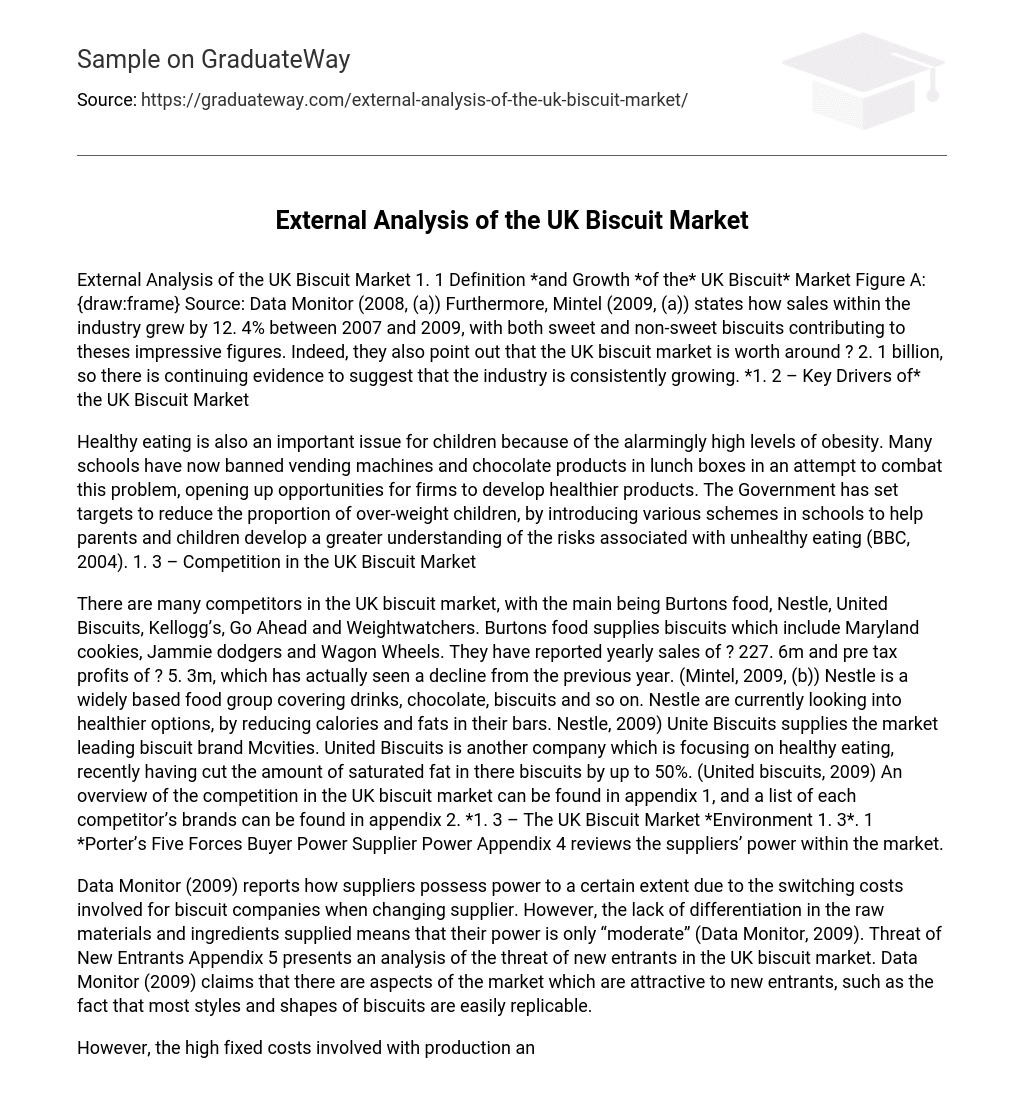Healthy eating is also an important issue for children because of the alarmingly high levels of obesity. Many schools have now banned vending machines and chocolate products in lunch boxes in an attempt to combat this problem, opening up opportunities for firms to develop healthier products. The Government has set targets to reduce the proportion of over-weight children, by introducing various schemes in schools to help parents and children develop a greater understanding of the risks associated with unhealthy eating (BBC, 2004).
There are many competitors in the UK biscuit market, with the main being Burtons food, Nestle, United Biscuits, Kellogg’s, Go Ahead and Weightwatchers. Burtons food supplies biscuits which include Maryland cookies, Jammie dodgers and Wagon Wheels. They have reported yearly sales of 227. 6m and pre tax profits of 5. 3m, which has actually seen a decline from the previous year. (Mintel, 2009,
Nestle is a widely based food group covering drinks, chocolate, biscuits and so on. Nestle are currently looking into healthier options, by reducing calories and fats in their bars. Nestle, 2009) Unite Biscuits supplies the market leading biscuit brand Mcvities. United Biscuits is another company which is focusing on healthy eating, recently having cut the amount of saturated fat in there biscuits by up to 50%. (United biscuits, 2009)
Data Monitor (2009) reports how suppliers possess power to a certain extent due to the switching costs involved for biscuit companies when changing supplier. However, the lack of differentiation in the raw materials and ingredients supplied means that their power is only “moderate” (Data Monitor, 2009).
However, the high fixed costs involved with production and the consumer brand loyalty which exists in the market both create significant barriers to entry for new entrants, meaning that their threat is only moderate (Data Monitor, 2009). Data Monitor (2009) states how there are many possible substitutes for consumers and retailers, such as fruit and crisps, but that these may be inferior to biscuits. For example, fruits have a shorter shelf life and so may be more costly to store, and other snacks may take up more space.
Nevertheless, the threat of substitutes is still seen as moderate (Data Monitor, 2009). Rivalry Appendix 7 looks at the different factors which influence how fierce the competition is in the UK biscuit market. There are high fixed costs within the industry, and “capacity increases are relatively easy to implement” (Data Monitor, 2009: 20), both of which increase the intensity of the competition between firms. Differentiation is relatively low, and many of the players “remain dependent on the income from sales on biscuits” (Data Monitor, 2009: 20). Therefore, it is clear that there is a strong rivalry between firms in the market.
It also provided a base to allow consumer groups segmented by their profiles to be coupled with a product that they would be most inclined to use. Information from both sources was drawn together and used to group customers into seven segments with similar characteristics and buying behaviour. Customer profiles where then drawn up for these segments to allow an assessment of their sought benefits, lifestyles, buying behaviour and other characteristics.
Mintel (2009) report that the healthier biscuit comes second in terms of growth in sales between 2006 and 2009 (23. 5% growth) and held the largest percentage share of the product market at 25%. The children’s biscuit market is relatively saturated however, with only 1. 4% growth in sales over the same period, but due to this lack of healthy biscuits, it was perceived that a combination of the two segments would be both successful and profitable.
By distributing only in the South West, this will in turn create brand awareness for not only the residents of these areas, but also for tourists who visit the region during holidays. This, combined with the promotional strategy, will hopefully create “word of mouth” promotion from consumers which will then lead to national demand from our target market. Consequently, consumers will begin to ask the dominant supermarkets for Gonzo’s biscuits, and they will then approach the producers to request an order so that consumer demand is satisfied.
The “Pull” strategy that is adopted for Gonzo’sBiscuit Bites is heavily reliant on the initial success of the launch within the south-west region. A marketing strategy of any kind is ultimately dependent on consumer awareness. This is where promotion of the product plays an imperative role, in order to create this awareness and consequent success. The promotion of a product involves balancing the seven main elements of the promotional mix (Jobber & Fahy, 2006), such as advertising and sales promotion, but it is important to consider the costs available.
The most significant reason for starting a regional sales campaign rather than a national campaign is the cost, and the cost of launching a regional campaign instead of a national one is far less meaning that it is a more realistic idea. For the launch of the product, Gonzo’s will use advertising and sponsorship. Television & Cinema Adverts The new product will be advertised regionally through television networks. Although it is expensive and hard to measure the success rate, television advertising is still one of the most effective ways to create brand awareness (Jober & Fahy, 2006).
The animated story-line will be enjoyable and humorous for both boys and girls, as both Gonzo and his wife are shown to be eating the biscuits at the end of the story. At the same time the healthy facts about the product at the end of the advert will encourage the parents to buy it for their kids. The same advert will be used in cinemas and will be shown before films with a U or PG rating, as this is a clear opportunity to directly target both children and the parents who are accompanying their children.





